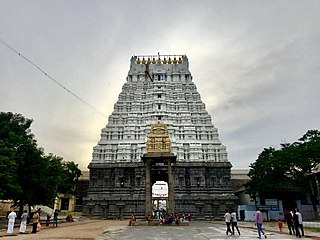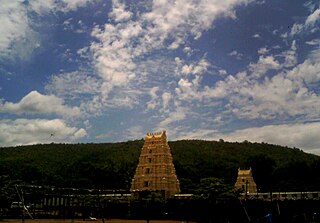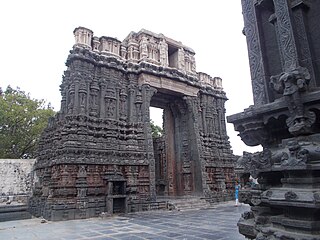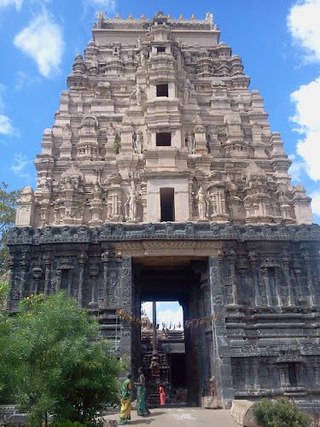
Ksheerarama is one of the five Pancharama Kshetras that are sacred to the Hindu god Shiva. The temple is located in Palakollu of West Godavari in the Indian state of Andhra Pradesh. Shiva is known locally as Ksheera Ramalingeswara Swamy. It is believed that staying one day in Kshirarama is equivalent to staying one year in Varanasi. It is one of the centrally protected monuments of national importance.

Kumararama or Bhimarama is one of the five Pancharama Kshetras that are sacred to the Hindu god Shiva. The temple is located in Samalkota of Kakinada district in the Indian state of Andhra Pradesh. The other four temples are Amararama at Amaravati(Dist. Guntur), Draksharama at Draksharama, Ksheerarama at Palakollu and Somarama at Bhimavaram(both in Dist. West Godavari). It is one of the centrally protected monuments of national importance.

Varadharaja Perumal Temple, also called Hastagiri and Attiyuran, is a Hindu temple dedicated to Vishnu located in the city of Kanchipuram, Tamil Nadu, India. It is one of the Divya Desams, the 108 temples of Vishnu believed to have been visited by the 12 poet saints, or the Alvars. It is located in a suburb of Kanchipuram known as the Vishnu Kanchi that is a home for many famous Vishnu temples. One of the greatest Hindu scholars of Vaishnava Vishishtadvaita philosophy, Ramanuja, is believed to have resided in this temple.

Tadipatri or Tadpatri is a city in Anantapur district of the Indian state of Andhra Pradesh at the border of Kurnool district and Kadapa district. It is the mandal headquarters of Tadipatri mandal in Anantapur revenue division. The Chintala Venkataramana Temple is located on a five-acre site in Tadipatri. The Bugga Ramalingeswara Temple is located one kilometer from the town, overlooking the Penna River.
Pemmasani Nayaks were a ruling clan in the south Indian state of Andhra Pradesh. They came into prominence during Vijayanagara Empire. After the Battle of Talikota in 1565 AD, the collapse of Vijayanagara Empire led to the emergence of Pemmasani Nayakas in the Rayalaseema region. They belonged to the Kamma social group.

Virupaksha Temple is located in Hampi in the Vijayanagara district of Karnataka, India. It is part of the Group of Monuments at Hampi, designated as a UNESCO World Heritage Site. The temple is dedicated to Sri Virupaksha. The temple was built by Lakkan Dandesha, a nayaka (chieftain) under the ruler Deva Raya II, also known as Prauda Deva Raya of the Vijayanagara Empire.

Veerabhadra temple is a Hindu temple located in the Lepakshi, in the state of Andhra Pradesh, India. The temple is dedicated to the Virabhadra, a fierce form of the god Shiva.

Mahanandi is a village located east of the Nallamala Hills of Nandyal District, Andhra Pradesh, India. It is surrounded by forests. Within 15 km of Mahanandi, there are nine Nandi shrines known as Nava nandulu. Mahanandi is one of the Nava Nandis. The Mahanandiswara Swamy Temple, an important shrine, is located here. This ancient temple dates back over 1,500 years. The inscriptions of 10th century tablets speak of the temple being repaired and rebuilt several times.

Sri Bhramaramba Mallikarjuna Temple or Srisailam Temple is a Hindu temple dedicated to the deities Shiva and Parvati, located at Srisailam in the Indian state of Andhra Pradesh.

Pallikondeswara Temple(also Pradosha kshetram) is a Hindu temple dedicated to the god Shiva located in Surutupalle, a village in Tirupati district of Andhra Pradesh, India. The presiding deity Pallikondeswara, unlike other Shiva temples, is sported in reclining posture lying on the lap of his consort Parvati.

The Ranganatha Swamy and the Someshwara temples are located in the historic town of Magadi, about 41 km from Bangalore, the capital of the Indian state of Karnataka. These temples are protected monuments under the Karnataka state division of the Archaeological Survey of India.

Pushpagiri Temple Complex is a temple complex located in Kadapa district in Andhra Pradesh, India. Founded around 7th Century CE, it houses some of the oldest temple congregations in the region.

Amararama is one of the five Pancharama Kshetras that are sacred to the Hindu god Siva. The temple is located in Amaravathi town of Palnadu district in the Indian state of Andhra Pradesh. Amareswara Swamy or Amaralingeswara Swamy refers to Lord Shiva in this temple. The temple is situated on the southern bank of Krishna River. The consort of Lord Amareswara Swamy is Bala Chamundika. The Sivalinga at this place is installed and established by Lord Indra.

Lakshmi Narasimha Temple is a Vaishnavite temple and one of the eight sacred places of Lord Vishnu in India. It is also known for being one of the eight mahakshetras Narasimha in India. It is situated at the foot of the Auspicious Hill in Mangalagiri which is part of the Mangalagiri Tadepalle Municipal Corporation part of Guntur district of Andhra Pradesh, India. It is one of the temples in the series of three temples located on and at the bottom of the hill, the other two being Panakala Narasimha Temple on the hill and Gandala Narasimha Temple at the top of the hill. It has one of the highest gopurams in South India and only one of its type in this part of India. It is 153 feet (47 m) in height and 49 feet (15 m) wide and has eleven storeys.

Chintalarayaswamy Temple or Sri Chintala Venkataramana Temple is a Hindu Vaishnavite temple situated at Tadipatri, a town in the Anantapur District of Andhra Pradesh, India. The Temple is dedicated to Venkateswara, a form of Vishnu, who is referred to as Chintala Venkataramana. The temple was built by Pemmasani Timmanayudu II of the Pemmasani Nayaks. It is situated on the bank of the Penna River, which passes through the town. The temple has granite sculptures and is classified as one of the Monuments of National Importance by Archaeological Survey of India (ASI). The temple has a Garuda Mandapa built as chariot with rotating granite wheels, which is similar to the one found in the Vithala Temple of Hampi.

Pemmasani Ramalinga Nayudu I was a member of the Pemmasani Nayak clan in the 15th century Vijayanagara Empire in southern India. He developed the hamlet of Tallapalle, renaming it to Tadipatri upon orders of the Vijayanagara emperor. He built a fort in the town and the Bugga Ramalingeswara Temple. Another temple to Obaleswara in Kurnool District is also attributed to him.

Pemmasani Timmanayudu II was a member of the Pemmasani Nayaks. He was the son of Pemmasani Ramalinga I and a contemporary of Vira Narasimharaya and Krishnadevaraya. After the death of his father, Timmanayudu went to inform the Vijayanagara Emperor of the progress made in developing the Rayalaseema region. The emperor was so pleased with what he heard that he made Timmanayudu the commandant of the Gandikota Fort on behalf of Saluva Govindaraja, its governor. Then, Timmanayudu gave control of Yadiki and Tadipatri, which were previously controlled by his ancestors, to a relative and shifted to Gandikota.
Pemmasani Erra Timmanayudu, also known as Pedda Timmanayudu or Yara Timmanayudu, was a member of the Pemmasani Nayaks in the 16th century Vijayanagara Empire in South India. He is credited for the rise of Rama Raya to the throne of Vijayanagara, and he was the commandant of the Gandikota Fort. His brother was the notable Commander Pemmasani Ramalinga Nayudu.

Madhavaraya Temple is a 16th century Hindu temple located in the Gandikota Fort, in the Kadapa district of Andhra Pradesh, India. Dedicated to Krishna ("Madhava"), it is also known as Madhava Perumal Temple or Madhavaraya Swamy Temple. The Government of India has designated it as a Monument of National Importance.
The Yogananda Lakshmi Narasimha Swamy Temple, also known as Mattapalli Narasimha Temple, is a Hindu temple dedicated to Narasimha, the half-man half-lion avatar of Vishnu, and his consort Lakshmi. It is located in Mattampally, a village in the Mattampally mandal of Suryapet district in the Indian state of Telangana. One of the Pancha Narasimha Kshetras, the temple is located on the banks of the Krishna River, and was built in the 11th century by Anumala Machi Reddy, the king of Thangedu region after the deity appeared in his dream and instructed him to do so. The main shrine houses a swayambhu (self-manifested) idol of Narasimha as Yogananda Lakshmi Narasimha, and was worshipped by sage Bharadvaja and other seers for hundreds of years before the temple was constructed. Lakshmi is worshipped here as Rajalakshmi Thayar and Chenchu Lakshmi Thayar.






























